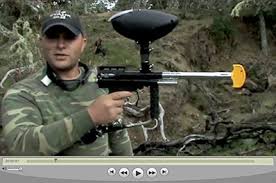Ridding an ecosystem of invasive plants is never easy. We can bring in goats to munch on offending plants or force armies of schoolchildren into slavery to pull them out; but, in all likelihood the sneaky little devils (the invasive plants, not the schoolkids) will be re-sprouting and back with a vengeance before we can turn around. For many invasive plant infestations the most practical long-term solution is chemical control – in other words, herbicides. Of course, herbicides have their issues such as drift and potential impacts on non-target plants. And what do you do when you want to get rid of invasive plants in a remote, sensitive ecosystem with limited access? Enter Herbicide Ballistic Technology (HBT). The HBT system uses the same technology as a recreational paint-ball gun but instead of filling the projectiles with paint, the balls are filled with triclopyr, which is commonly used in homeowner products for brush and poison ivy control.

Dr. James Leary at the University of Hawaii has been exploring the use of HBT to control invasive plants in various ecosystems in Hawaii. Most of the time Dr. Leary and his colleague use the standard paintball HBT system, but for the big jobs they call in the heavy artillery – literally. Dr. Leary recently presented a seminar here at MSU on work he and his team have conducted in conjunction with the Maui Invasive Species commission to eliminate populations of Miconia calvacens, one of the most problematic invasive trees in Hawaii. According to the seminar abstract, Dr. Leary reports “Our best utility for HBT deployment on a Hughes 500D helicopter platform featuring real-time capabilities in target elimination. …we have conducted 17 tactical search and destroy mission covering a total net area of 3,888 ha and eliminating 7,463 Miconia targets.”

Clearly the war on invasive has been raised to a different level



